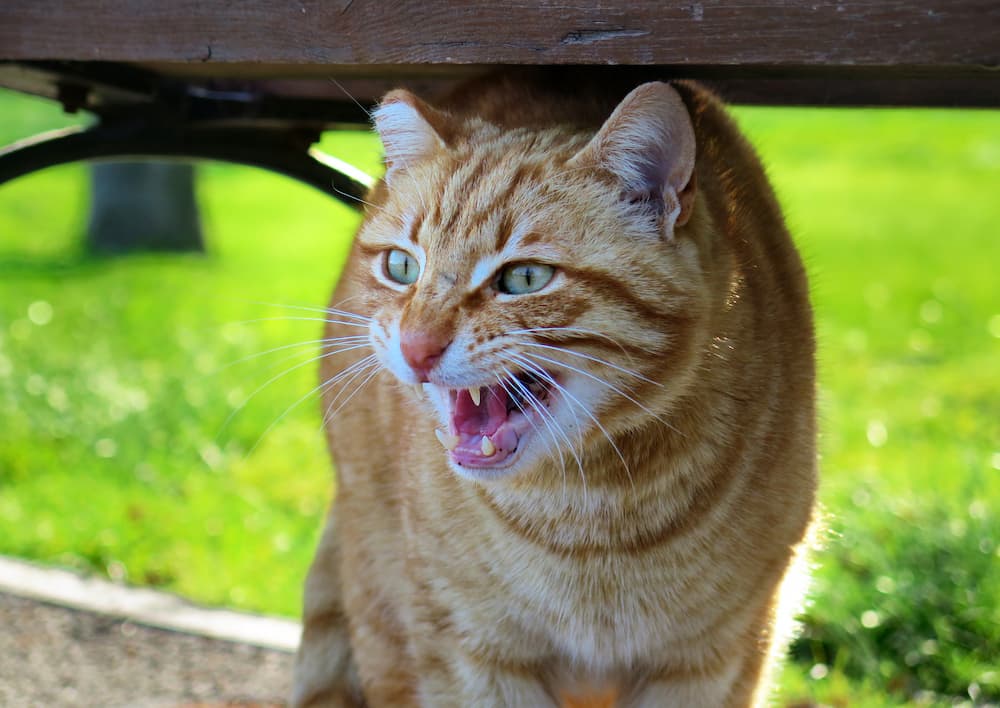Aggression in Cats
Published on July 14, 2011

Cats become aggressive and lash out at or attack other pets –– and people –– for all kinds of reasons — fear, defense of territory, pain, overly enthusiastic play, and more. Early socialization, sterilization, behavioral modification, and drugs are the most common methods for avoiding and treating feline aggression.
Overview
Aggression is among the most common behavioral issues seen in cats. In most cases the behavior is completely natural and appropriate, though it’s undeniably the case that its manifestation(s) may at times interfere with the peaceable workings of a normal human household.
Generally classified as intermale, territorial, fear/defensive, play, predation, and redirected aggression (though other forms may exist), aggression may be avoidable. And when it’s not, it’s often treatable.
Before initiating any kind of behavioral therapy, consult your veterinarian to determine if there is a medical cause for your cat’s aggression. Your veterinarian can also recommend some tactics for dealing with an aggressive cat to prevent injury to others in your household or to the cat itself.
Symptoms and Identification
Aggression can be a complicated condition to evaluate in any species but arguably more so in cats. Some cats may exhibit a single form of aggression, while others may exhibit several types of aggression simultaneously. Understanding the different types of aggression can help get to the root of the problem, but professional help is often invaluable due to the complex nature of the average feline disposition.
- Fear/defensive aggression occurs when a cat is afraid — as when going to the veterinary hospital. Typical body language displayed is a cat hunched down low, ears back with its legs and tail tucked up under the body.
- Intercat aggression is directed at other cats inside and/or outside the household.
- Intermale aggression is the most common form of feline aggression. It happens most commonly among unneutered male cats by way of protecting individual resources such as territory, access to food, and females.
- Pain aggression is a protective reaction by a cat in pain. This aggression can occur when a cat is touched or moved or anticipates being handled.
- Play aggression occurs with play behaviors such as interkitten fighting.
- Predatory aggression is associated with predation (e.g., stalking, hunting, or catching small animals). This aggression usually involves a sudden attack, a severe bite, and shaking of the prey, but may be directed at humans, other cats, or other animals. Cats learn predatory behavior from their mothers and will typically practice on littermates.
- Redirected aggression occurs when a cat cannot attack an intended target (usually another cat) and redirects his or her aggression toward another target (usually his/her housemate).
- Territorial aggression occurs when a cat protects a territory, such as a yard or house, typically from another cat.
- Petting-induced aggression happens when a cat that enjoys being petted suddenly turns on the person petting him. “Love biting” is what cat lovers have termed this behavior, but the reality is that it’s a poorly understood behavior with no clear explanation.
Diagnosis is made on the basis of signalment data (male, female, sterilization status, etc.), the pattern of aggressive postures displayed by the aggressive cat, and the circumstances in which the aggressive behaviors occur.
Affected Breeds
A cat of any breed can become aggressive.
Treatment
Treatment varies with the type of aggressive behavior. Sterilization, behavioral modification therapy, and pharmacologic intervention are the most common methods for treating feline aggression.
In any case, treating aggression is usually complex. If severe, a treatment plan should be designed and supervised by a behavior specialist. Look for a certified applied animal behaviorist (CAAB or ACAAB) or a veterinary behaviorist (DACVB).
Prevention
Preventing feline aggression is generally considered less predictable an endeavor than for canine aggression. As for dogs, however, the most critical feature of this approach involves early and frequent socialization with humans, dogs, and other animals. Socialization with people should begin as soon as possible, and socialization with other animals can start once your veterinarian has administered the necessary vaccines and wellness care.
This article has been reviewed by a Veterinarian.


